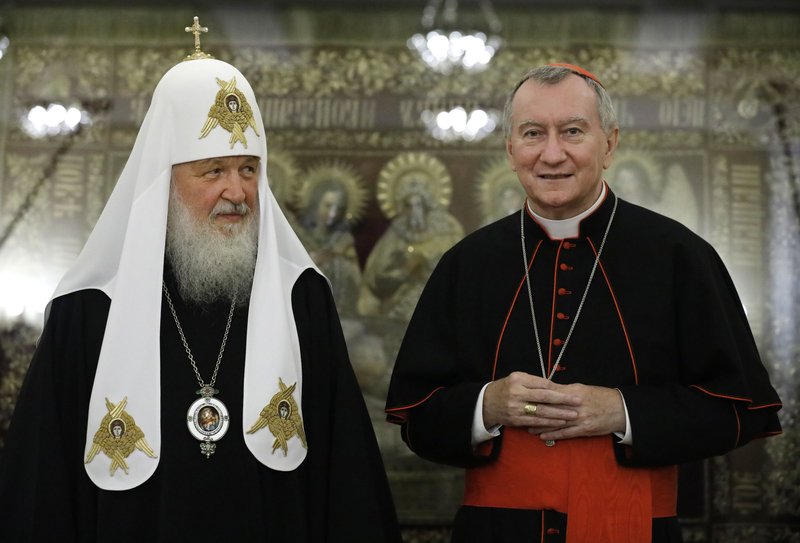Catholics in Russia are a tiny minority: 773,000 faithful
Catholics in Russia are a tiny minority: 773,000 faithful, scattered over four dioceses that John Paul II established. This move greatly upset the Rus
Sep 10, 2017

By Gerard O’Connell
Catholics in Russia are a tiny minority: 773,000 faithful, scattered over four dioceses that John Paul II established. This move greatly upset the Russian Orthodox Church, which accused Rome of proselytising. The climate has now changed between the Orthodox Church and the Holy See, but for Catholics in Russia, life is still not easy. The cardinal met their bishops and celebrated Latin Mass in the Cathedral of the Immaculate Conception in Moscow on Aug. 21, which was filled to capacity. Later, he said he was touched “by the faith and devotion” of the people there and by their “attachment to the Pope.” He said he would help them by raising their concerns with the highest authorities in the land.
He said he spoke with President Putin and Foreign Minister Lavrov about “several situations of some difficulty” for the Russian Catholic community. These included the difficulty in obtaining visas for foreign clergy to work in Russia and the failure of the authorities to restore the churches that were confiscated during the Communist era.
There is already one result from the visit: Both sides agreed to the mutual acceptance of diplomatic passports for their respective officials without them having to go through the normal visa process.
When the cardinal and the foreign minister met the press after their meeting, Mr Lavrov emphasised that Russia’s relationship with the Holy See is not new. It dates back to the 15th century and, he recalled, since the late 18th century, the Holy See has sent regular missions to Russia. In 1817, Russia opened its first permanent mission to the Holy See. From the Russian point of view, the two sides have a long history together and understand each other.
While Cardinal Parolin’s conversations with Russia’s president and foreign minister were undoubtedly of great importance, his meetings with Patriarch Kirill and Metropolitan Hilarion were no less so. Each encounter lasted around two hours and reflected the new climate in relations between the Orthodox Church and the Holy See after last year’s Havana meeting.
The cardinal brought Patriarch Kirill “a fraternal message” and a gift from Pope Francis. Patriarch Kirill stated that “a new stage in the development of our relations has begun, marked by important facts. The common positions allow us to design plans and endow them with real content.” He raised the possibility of joint Russian Orthodox-Catholic humanitarian projects to help people suffering from the conflicts in the Middle East.
The cardinal told Vatican media that, besides the Havana meeting, another event contributed to current relations: the bringing of the relics of St Nicholas of Myra to Russia from Bari by Cardinal Kurt Koch, the president of the Pontifical Council for Christian Unity.
He said the Orthodox leaders told him they were overjoyed and “touched by the faith and religiosity of the people” as some 2.5 million people venerated the relics in Moscow and St. Petersburg during the two months they were on display. He said many Russians who belong to the Orthodox tradition but do not practise moved closer to the Church on this occasion.
The Vatican diplomat revealed that, during his two-hour meeting with Metropolitan Hilarion at the Danilovsky Monastery, the discussion, in many ways, mirrored the ones he had with President Putin and Mr Lavrov, including peace in Syria, the plight of Christians in the Middle East and the political situation in Venezuela. The cardinal and Metropolitan Hilarion also discussed Ukraine, focusing on ecumenical harmony and peace in that land. Sources within the Orthodox Church said Metropolitan Hilarion raised cases of “political statements and aggressive actions” by members of the Ukrainian Greek Catholic Church that are loyal to Rome.
An issue that was not raised was the possibility of a second meeting between the Pope and the patriarch, or a visit by Pope Francis to Moscow. But, as Parolin told Italian media, “in this new climate, there is the will on the part of all to continue on the journey and to make other signs and gestures that can consolidate this journey.”
Cardinal Parolin’s visit has been positive for all sides. It has enhanced trust between both the Holy See and the Russian government, and between the Holy See and the Russian Orthodox Church. This augurs well for the future on both fronts. It could encourage new political initiatives in relation to some of the conflicts discussed, open the way to more joint humanitarian and cultural initiatives with the Orthodox, and bring benefits to the Catholic community in that land. All in all, the visit proves, yet again, that the culture of encounter and dialogue advocated by Pope Francis is the way to build constructive and peaceful relations in today’s world. -- America Magazine







Total Comments:0